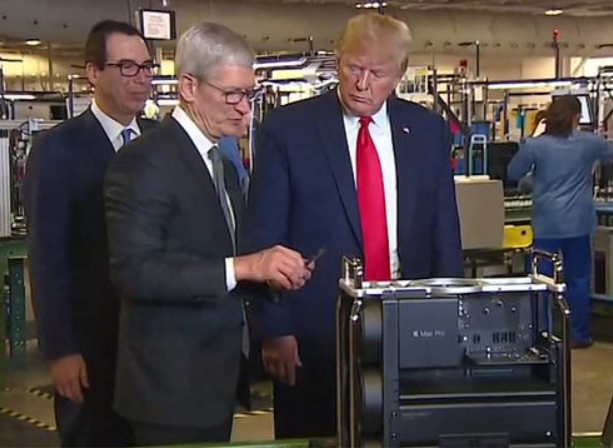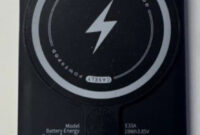There is a significant movement to have iPhones manufactured in the United States. In theory, this could generate numerous jobs, ranging from assembling the phones to constructing the necessary factories for their assembly.
Howard Lutnick, the Secretary of Commerce for the U.S., appeared on CBS News’ “Face the Nation” earlier this month to support the Trump tariffs that have been impacting the global economy.
During that discussion, the commerce secretary outlined a vision that included creating employment opportunities for American workers by relocating electronics manufacturing, primarily from China, back to the U.S.
As Lutnick indicated in the April 6 broadcast, the critical aspect will be automated factories. “Who will construct these factories? Who will run them? Who will ensure they function effectively? Great American workers,” he stated.
“You know, we are going to replace … the thousands of workers who are simply assembling parts to create iPhones; that sort of work will return to America,” he remarked.
A commitment to restore electronics manufacturing jobs from overseas—a process referred to as “reshoring”—has been discussed by President Donald Trump since his first term, and Lutnick’s comments are just the latest expression of that promise. For some, it is an attractive concept that forms a core element of the Trump administration’s economic objectives.
However, it is also quite improbable to occur, especially in the near future. Here’s the explanation.
What is Apple’s position on manufacturing iPhones in the United States?
If Apple is aligned with Lutnick’s vision of U.S. factories employing automation to “assemble parts to create iPhones,” the company is not sharing this information openly. I reached out to Apple to inquire whether they have engaged with the Trump administration regarding the possibility of producing iPhones domestically, but I have not received a response.
To be fair to Apple, the company has demonstrated its intentions regarding some manufacturing initiatives through financial commitments.
In February, the company revealed plans to invest over $500 billion in expanding its U.S. operations over the next four years. These plans include a facility in Houston that will manufacture servers as part of its Apple Intelligence initiatives, along with other projects aimed at strengthening manufacturing efforts.
This latest investment builds upon previous commitments by Apple, such as a campus in Austin, Texas, where the company assembles Mac Pros.
So indeed, Apple manufactures certain products in the U.S. with intentions to increase that production. However, a careful observation will reveal that manufacturing servers and Mac Pros is not the same as making iPhones.
“[Apple] is capable of [producing some Macs in the U.S.] because they are sold in smaller quantities, not millions or tens of millions,” explained Avi Greengart, lead analyst at Techsponential, when I asked him to clarify why Apple produces certain items domestically but not others. “The manufacturing specifications and tolerances of a desktop computer are also notably less strict than those of smartphones.”
There is also the issue of costs, with the Mac Pro starting at $6,999. This is considerably higher than the $599 price of Apple’s least expensive phone, the iPhone 16e.
“The financial stakes are greater [with the Mac Pro], which helps obscure the increased labor costs associated with operating in the U.S.,” Greengart noted.
Other challenges hindering iPhone manufacturing
Thus, this may clarify why iPhones are not currently manufactured in the U.S. What obstacles exist in transferring this production to American soil?
Let’s begin with labor costs, as a major reason for the shift of production overseas is that workers earn lower salaries in other countries. Even now, as IDC’s group vice president for worldwide device trackers, Ryan Reith, highlighted to my colleague Tom Pritchard in an article about the effects of the Trump tariffs on phones, more production is relocating to nations like India and Indonesia in response to rising labor costs in China.
In other words, forget about phone assembly jobs moving to America, where wages are even higher. This is why Lutnick’s remarks to CBS emphasized the importance of automated factories.
Phone production predominantly occurs overseas because that is where the components needed for phones are assembled as well. There’s a well-known anecdote about Apple changing the display of the original iPhone to glass during the six-month stretch between the device’s announcement and its launch in June 2007.
Several fortunate factors allowed this last-minute modification to be feasible, but a significant reason was that Foxconn, the iPhone supplier, had the manufacturing capacity to swiftly fulfill that request. Such an occurrence is unlikely if production were to be brought back to the U.S.
According to Greengart, “Phones have components sourced from South Korea, Taiwan, China, the U.S., Japan, and additional regions, and they rely on essential inputs from an even broader array of locations.”
The most plausible situation for iPhone assembly to occur in the United States would likely be for only the final assembly to take place there. “In my view, it would never be practical, nor feasible, to have the entire end-to-end process completed in the U.S.,” remarked IDC’s Reith. “It simply doesn’t make sense.”
However, even concentrating exclusively on final assembly would necessitate a significant effort to construct facilities and equip them with the tools required to finalize smartphones.
Reith predicts it would take around three years before small-scale production could begin, with mass production potentially taking five years — and he has characterized that timeline as a best-case scenario to Tom’s Guide.
“It would be extremely costly to build from the ground up, labor expenses would increase, education in engineering and machine tooling would need to be developed, immigration policies would have to be relaxed, and the entire process would demand extensive automation,” Greengart explained. “At the end of this process, you might still find the products to be more expensive, yet they would be primarily sourced and completely assembled in the U.S.”
Regarding the production of iPhones, how much more expensive would a U.S.-assembled iPhone be? Before the Trump administration reduced some tariffs while temporarily exempting smartphones from the elevated rates, Dan Ives, who leads global technology research at Wedbush Securities, stated on CNN that a U.S.-constructed iPhone would cost $3,500.
Even if that figure seems unrealistic, his statement that a U.S.-produced iPhone is a “fictional tale” appears to be a reasonable assertion, considering the numerous challenges involved in making it a reality.
As Greengart noted during his discussion about tariffs with my colleague Tom Pritchard, there are both business and political benefits to relocating some manufacturing back to the U.S. “Nevertheless, the current incentives, expenses, and fluctuating regulatory landscape do not motivate investment towards this outcome,” he continued.
That certainly appears to align with my findings on phone manufacturing.
Apple has announced that it will invest over $500 billion in the U.S. in the next four years
This new commitment represents Apple’s largest financial pledge to date and further strengthens its long-standing support for American innovation and advanced high-skilled manufacturing. The investment will fund various initiatives aimed at artificial intelligence, silicon engineering, and skills development for students and workers nationwide.
“We are optimistic about the future of American innovation and proud to enhance our extensive investments in the U.S. with this $500 billion commitment,” said Tim Cook, CEO of Apple. “From increasing our Advanced Manufacturing Fund to establishing advanced technology in Texas, we are excited to broaden our support for American manufacturing. We will continue collaborating with individuals and companies throughout the country to help create an extraordinary new chapter in American innovation.”
As part of this investment initiative, Apple and its partners will launch a new advanced manufacturing site in Houston to produce servers that empower Apple Intelligence, a personal intelligence system designed to help users compose text, express ideas, and accomplish tasks. Additionally, Apple will increase its U.S. Advanced Manufacturing Fund, establish an academy in Michigan to educate the next generation of U.S. manufacturers, and enhance its investments in research and development in America for cutting-edge domains like silicon engineering.
The $500 billion commitment encompasses Apple’s collaborations with thousands of suppliers across all 50 states, direct employment opportunities, the infrastructure for Apple Intelligence and data centers, corporate facilities, and Apple TV+ productions in 20 states. Apple continues to be one of the largest taxpayers in the U.S., contributing over $75 billion in taxes over the last five years, including $19 billion in 2024 alone.
Currently, Apple supports more than 2.9 million jobs across the United States through direct employment, collaboration with U.S.-based suppliers and manufacturers, and developer roles within the burgeoning iOS app ecosystem.
Apple will begin collaborating with manufacturing partners to establish production of servers in Houston later this year as part of its new investment strategy. A server manufacturing facility measuring 250,000 square feet is expected to open in 2026, generating thousands of job opportunities.
Previously made outside the U.S., the servers assembled in Houston will be crucial in powering Apple Intelligence and will serve as the backbone of Private Cloud Compute, which integrates robust AI processing with an advanced security architecture that is unparalleled in scale for AI cloud computing. The servers incorporate years of research and development conducted by Apple engineers and provide the industry-leading security and performance of Apple silicon in data centers.
Apple’s team has designed these servers to be highly energy-efficient, significantly lowering the energy needs of Apple’s data centers, which already operate on 100 percent renewable energy. As Apple rolls out Apple Intelligence to customers nationwide, the company also plans to keep expanding its data center capabilities in North Carolina, Iowa, Oregon, Arizona, and Nevada.
As part of this new investment, Apple is increasing the size of its U.S. Advanced Manufacturing Fund, which was established in 2017 to promote high-class innovation and high-skilled manufacturing jobs across the country. The fund will be doubled from $5 billion to $10 billion, focusing on advancing manufacturing and skills development throughout the nation.
The expansion of the fund includes a multibillion-dollar commitment from Apple to manufacture advanced silicon at TSMC’s Fab 21 facility in Arizona. Apple is the primary customer of this cutting-edge facility, which employs over 2,000 workers to produce the chips within the United States. Mass production of Apple chips commenced last month.
The silicon developed for Apple is engineered to provide users with remarkable features, performance, and energy efficiency across their devices. Currently, Apple’s suppliers produce silicon at 24 factories in 12 states, including Arizona, Colorado, Oregon, and Utah. The company’s investments in this sector contribute to the creation of thousands of high-paying jobs across the nation at American firms such as Broadcom, Texas Instruments, Skyworks, and Qorvo.
So far, Apple’s U.S. Advanced Manufacturing Fund has backed projects in 13 states—such as Kentucky, Pennsylvania, Texas, and Indiana—that have fostered the growth of local businesses, trained workers, and developed a diverse array of innovative manufacturing processes and materials for Apple products.
Increasing R&D Investments Nationwide in the U.S.
Apple is continually broadening its R&D efforts throughout the United States. Over the last five years, Apple has almost doubled its investment in advanced R&D within the U.S., and it plans to maintain this growth trajectory.
Recently, Apple introduced the latest addition to its iPhone series, the iPhone 16e. The iPhone 16e offers rapid, seamless performance and exceptional battery life, enabled by the industry-leading efficiency of the A18 chip and the newly developed Apple C1 — the first cellular modem created by Apple and the most energy-efficient modem ever in an iPhone. The Apple C1 represents a new milestone in the evolution of Apple silicon and is the product of years of R&D investment, showcasing the efforts of thousands of engineers. The Apple C1 marks the beginning of a long-term strategy aimed at allowing Apple to innovate and enhance the modem systems for future Apple products.
In the upcoming four years, Apple intends to recruit approximately 20,000 individuals, with most of them concentrating on R&D, silicon engineering, software development, and AI and machine learning. This expanded commitment encompasses substantial investment in Apple’s R&D centers nationwide. It also involves the growth of teams across the U.S. focusing on custom silicon, hardware engineering, software development, artificial intelligence, and machine learning.
Empowering American Businesses with a New Manufacturing Academy in Detroit
To assist companies in shifting towards advanced manufacturing, Apple is set to launch the Apple Manufacturing Academy in Detroit. Apple engineers, along with specialists from prominent universities such as Michigan State, will provide guidance to small and medium-sized enterprises on integrating AI and smart manufacturing practices. The academy will also offer complimentary in-person and online courses featuring a skills development curriculum that instructs workers on essential skills like project management and optimizing manufacturing processes.
These courses are designed to enhance productivity, efficiency, and quality within companies’ supply chains.
Apple has consistently prioritized investment in education and skills enhancement for American workers and students. This commitment includes ongoing and expanding grant initiatives for organizations like 4-H, Boys & Girls Clubs of America, and FIRST, which collaborate closely with Apple in communities nationwide to create free programs that teach young individuals critical skills like coding.
Apple’s dedication to nurturing the next generation of innovators also encompasses initiatives such as the company’s New Silicon Initiative, which equips students for careers in hardware engineering and silicon chip design. Last year, this program expanded to include students at Georgia Tech and now serves students at eight institutions across the nation. Apple is continuing to broaden this initiative, which includes a new partnership with UCLA’s Center for Education of Microchip Designers (CEMiD) beginning this year.



